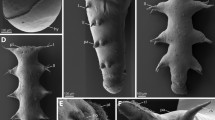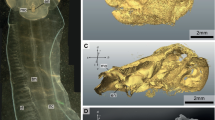Abstract
At present, ecotoxicological studies use physiological reactions of invertebrates, based on diverse reflexes, as biomarkers. The primary link of the reflex chain is presented by the chemo-, mechano- and osmoreceptors located on the body surface and inside the mantle cavity. Previously we hypothesized that the polymodal osphradial organ in the pond snail may participate in adaptive reactions of aquatic molluscs to toxicants. A known homology of osphradial components allows extending this suggestion to marine representatives of various Mollusca subclasses, although a great diversity of their structural organization and feeding methods as well as multiplicity of aquatic molluscs may hamper the interpretation of the coming ecotoxicological studies. To elucidate this issue, we carried out a comparative electron microscopic study of the osphradial organs in different families of prosobranchian molluscs (Gastropoda). Depending on ultrastructural features, five sensory cell complexes (SCC) were identified in the osphradial organs, and a putative connection of these complexes with the known chemo-, mechano- and osmosensory modalities was demonstrated. The SCC structure becomes more sophisticated during evolution of gastropods depending largely on feeding methods. Thus, the primitively organized osphradium in the herbivorous mollusc Viviparus sp. is a polymodal receptor organ representing a prototype for further morpho-physiological modification. The osphradium in a winkle (Littorina sp.) is the next step in evolutionary transformation, combining osmo- and chemosensory SCC. In the novel, “ctenidial”, type of osphradia the total receptor surface increases and ultrastructural specialization of SCC occurs promoting the emergence of carnivorous feeding. In predatory marine molluscs which actively hunt for prey using odor, the accessory superficial SCC is distinguished. It is located on the lateral surfaces and ventral edge of the osphradial petals, near the supporting ciliated cells, and appears to be a mechanoreceptor organ sensing the direction and rate of liquid flowing along the osphradium. Association of SCC with a certain sensory modality and feeding method is suggested.
Similar content being viewed by others
References
Beklemishev, V.N., Osnovy Sravnitel’noi Anatomii Bespozvonochnykh (Principles of Comparative Anatomy of Invertebrates), Moscow, 1964, vol. 2.
Lacaze-Duthiers, H., Du systeme nerveux des mollusques gasteropodes pulmones aquatiques et d’un nouvel organe d’innervation, Arch. Zool. Exp. Gen., 1872, vol. 1, pp. 97–168.
Demal, J., Essai d’histologie comparee des organes chemorecepteurs des Gasteropodes, Mem. Acad. roy. Belg., 1955, vol. 29, pp. 1–88.
Crisp, M., Fine structure of some prosobranch osphradia, Mar. Biol., 1973, vol. 22, pp. 231–240.
Kamardin, N.N. and Tsirulis, T.P., Electron microscopic investigation of the pond snail osphradium, Tsitologiya, 1980, vol. 22, no. 3, pp. 266–270.
Kamardin, N.N., Ciliary structures in osphradium of Murex saxatilis, Tsitologiya, 1985, vol. 27, pp. 986–989.
Haszprunar, G., The fine morphology of the osphradial sense organs of the Mollusca. I. Gastropoda, Prosobranchia, Phil. Trans. R. Soc. Lond. B., 1985, vol. 307, pp. 457–496.
Haszprunar, G., The fine morphology of the osphradial sense organs of the Mollusca. III. Placophora and Bivalvia, Phil. Trans. R. Soc. Lond. B., 1987a, vol. 315, pp. 37–61.
Haszprunar, G., On the origin and evolution of major gastropod groups, with special reference to the Streptoneura, J. Moll. Stud., 1988, vol. 54, pp. 367–441.
Weakley, B.S., Elektronnaya Mikroskopiya dlya Nachinayushchikh (A Beginner’s Handbook in Biological Electron Microscopy), Moscow, 1975.
Vinnikov, Ya.A., Evolution of chemoreception, Arkh. Anat. Gistol. Embriol., 1987, vol. 93, no. 11, pp. 5–26.
Bronshtein, A.A., Obonyatel’nye Retseptory Pozvonochnykh (Olfactory Receptors of Vertebrates), Leningrad, 1977.
Taylor, G.D. and Kamardin, N.N., Evolution of receptor cells of chemosensory osphradial organ in prosobranchia molluscs (Prosobranchia, Gastropoda), Sensornye Sistemy, 1992, vol. 6, no. 3, pp. 78–82.
Kamardin, N.N. and Nozdrachev, A.D., Osfradial’nye Sensornye Sistemy Mollyuskov (Osphradial Sensory Systems of Molluscs), St. Petersburg, 2004.
Kamardin, N., Szucs, A., and Rozsa, K.S., Influence of HgCl2 on osphradial multisensory system of Lymnaea stagnalis, Acta Biol. Hung., 1999, 50(1–3), pp. 99–116.
Curtis, T.M., Williamson, R., and Depledge, M.H., The initial mode of action of cop per on the cardiac physiology of the blue mussel, Mytilus edulis, Aquatic Toxicology, 2001, vol. 52, pp. 29–38.
Liedtke, W., TRPV channels’ role in osmotransduction and mechanotransduction, Handbook Exp. Pharmacol., 2007, vol. 179, pp. 473–487.
Cameron, P., Hiroi, M., Ngai, J., and Scott, K., The molecular basis for water taste in Drosophila, Nature, 2010, vol. 465 (7294), pp. 91–95.
O’Neil, R.G. and Heller, S., The mechanosensitive nature of TRPV channels, Pflugers Arch., 2005, vol. 451(1), pp. 193–203.
Author information
Authors and Affiliations
Corresponding author
Additional information
Original Russian Text © N.N. Kamardin, 2014, published in Zhurnal Evolyutsionnoi Biokhimii i Fiziologii, 2014, Vol. 50, No. 6, pp. 470–478.
Rights and permissions
About this article
Cite this article
Kamardin, N.N. Putative structural-functional evolution of osphradial sensory surface in aquatic prosobranchian molluscs. J Evol Biochem Phys 50, 539–548 (2014). https://doi.org/10.1134/S002209301406009X
Received:
Published:
Issue Date:
DOI: https://doi.org/10.1134/S002209301406009X




